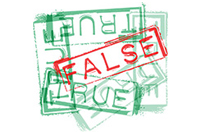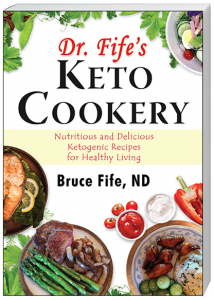 Look Out for Fake Ketogenic Recipes
Look Out for Fake Ketogenic Recipes
In 2014 I published a book titled The Coconut Ketogenic Diet. The focus of the book was how to use a coconut oil based ketogenic diet to lose excess weight and improve overall health. Within a few weeks after my book appeared on Amazon.com, a copycat book with a very similar title and cover design was posted. Unlike my book, this other book was a cookbook devoted entirely to ketogenic recipes. The author of the book intended to make it appear like his book was a companion volume to mine.
It was a Kindle book and didn’t cost much so, being curious, I ordered a copy. It was more of a booklet than a book. It contained only 21 recipes. Shockingly, none of the recipes were actually ketogenic and maybe only half could be considered even remotely low-carb. The recipes contained grains, potatoes, honey, and other high-carb ingredients. For someone looking for ketogenic recipes this book was a total waste, and even harmful.
A ketogenic diet is one that is very low in carbohydrate, high in fat, with moderate protein. Carbohydrate and protein intake must be limited in order for the body to produce ketones—an alternative fuel to glucose. Too much carbohydrate or protein will stop ketone production. The extra fat in the diet makes up for the missing carbohydrate calories. Much of dietary fat in a ketogenic diet is converted into ketones to be used to fuel our cells, so getting adequate fat is important.
One of the advantages of ketones is that they are a much more potent and efficient energy source than glucose. It is like putting a high-performance fuel into the gas tank of your car, you get better mileage, more power, with less wear and tear on the engine. The brain, in particular, runs much better using ketones for fuel and for this reason the diet is recommended for many neurological disorders. Another health issue that is greatly improved with ketones is diabetes. The underlying problem with type 2 diabetes is insulin resistance, in which the cells of the body are unable to effectively absorb glucose. Without glucose the cells cannot produce the energy they need to function and live, therefore, they began to degenerate and die. This is what leads to many of the symptoms and complications associated with diabetes. Cells, even if they are insulin resistant, easily absorb ketones, providing them the energy they need to function properly and prevent the complications associated with diabetes.
The ketogenic diet is a therapeutic diet that has been useful in treating a wide number of health problems including diabetes, obesity, Alzheimer’s, Parkinson’s, epilepsy, autism, heart disease, cancer, glaucoma, infertility, and others. Strictly following a ketogenic diet can control or even reverse these conditions.
For this reason, ketogenic diets have become increasingly popular. There are now numerous ketogenic cookbooks available. You can go online and find hundreds of ketogenic recipes. Coconut oil is beneficial in a ketogenic diet because it promotes the production of ketones better than any other fat and increases the efficiency of the diet.
I’ve written a number of books describing how to use a ketogenic diet to overcome various health problems. Although these books clearly explain what a ketogenic diet is and provide many sample recipes to get readers started, it is always helpful to have more tried and true recipes to choose from.
Most people simply turn to the Internet for recipes. This could be a big mistake! Don’t get me wrong, the Internet is a very useful tool and you can find a lot of good information there, but it is also a source of much misinformation, especially when it comes to diet and health. The Internet is the first place most people go when looking for ketogenic recipes. Unfortunately, a large number of these so-called ketogenic recipes are not really healthy or even ketogenic. They are loaded with carbohydrate, sweeteners, unhealthy fats, and other questionable ingredients. I would never recommend these recipes for people going on a ketogenic diet.
Many of the people posting these recipes assume that ketogenic is the same thing as low-carb. Not so. All ketogenic recipes are low-carb, but not all low-carb recipes are ketogenic. I have found that many of the so-called “ketogenic” recipes on the Internet are not truly ketogenic. Using these recipes will only hamper a person’s efforts to achieve nutritional ketosis and slow their progress. If someone is taking up a ketogenic diet for therapeutic reasons, he or she needs to make sure the recipes are actually ketogenic, otherwise the results will be disappointing and in the case of someone with a serious disease, like diabetes or cancer, it could be very harmful.
With the growing popularity of the keto lifestyle, ketogenic recipes abound. You can easily find hundreds of recipes not only on the Internet but in books and magazines as well. Many of them sound delicious, like keto cupcakes or keto ice cream…really? Is there such a thing?
A large number of the proclaimed ketogenic recipes on the Internet are desserts, treats, and sweets—brownies, cookies, pancakes, waffles, syrups, cinnamon rolls, candy—all of the type of foods that cause obesity and metabolic disease. Even most ketogenic cookbooks are loaded with sweet treats. There are some books devoted entirely to ketogenic desserts with gorgeous pictures of decadent-looking cakes and candies on the cover! What a scam! Do you really think that changing a few of the ingredients in these types of foods makes them healthy? They may not use grains or sugar, but they are not exactly health foods either. All of them are sweetened with zero-calorie artificial sweeteners or sugar substitutes. All sweeteners, regardless of the source, promote sweet addiction, overeating, and weight gain. They also promote metabolic problems.
People looking for ketogenic recipes generally just assume that any recipe that is labeled “ketogenic” or “low-carb” is actually ketogenic. Nothing could be further from the truth. The term “low-carb” is relative. For example, a single slice of ordinary chocolate cake may supply 50 grams of carbohydrate. A low-carb version of the same size piece of cake may supply 40 grams of carbohydrate. Forty grams is a lot of carbs when you are on a ketogenic diet in which your total carbohydrate allotment for an entire day may be only 20 or 30 grams. But since 40 grams is lower than 50 grams, the cake is labeled as being low-carb. And many low-carbers wonder why they don’t lose weight eating these pseudo low-carb foods.
In order to make low-carb and ketogenic foods taste as sweet and tempting as full-carb versions, low-calorie artificial sweeteners of all types are added, generally aspartame, Splenda, or stevia. Many people still fear fats, especially saturated fats, so they make their recipes low in fat or use margarine or vegetable oils in place of healthy saturated fats.
If you are wanting to follow a ketogenic diet to lose excess weight, manage diabetes, control epileptic seizures, stop or reverse Alzheimer’s or Parkinson’s, stop glaucoma, or achieve any of the documented benefits associated with the ketogenic diet, you MUST be eating meals that are actually ketogenic—not low-carb meals that are promoted as being ketogenic. If you are not comfortable with calculating the exact percentages of fat, protein, and carbohydrate in your meals, then you really don’t know if the recipes are truly ketogenic or not.
I believe many people fail to lose weight like they should, or see the improvements in their health like they should, when they go on a ketogenic diet because many of the foods they eat are not really ketogenic. They become discouraged and quit. Failure is not because the ketogenic diet didn’t work, it is because they used the wrong recipes.
Unfortunately, most ketogenic cookbooks contain a large portion of recipes that are not ketogenic, if they use any type of sugar substitute then the recipes become anti-ketogenic, and therefore potentially harmful as they will not provide the ketones the body needs to treat a serious health problem.
I was frustrated while searching for good ketogenic cookbooks because I couldn’t find any where all the recipes were truly ketogenic. I realized that other people would have a difficult time as well. That is what led me to write Dr. Fife’s Keto Cookery. I wanted to provide “real” ketogenic recipes using healthy ingredients. I wanted to compile a book of recipes that could be used to bring about all of the healing properties of ketosis that I discuss in my books.
Dr. Fife's Keto Cookery contains all of my favorite ketogenic recipes that I’ve accumulated and developed over the years, nearly 450 in all—far more than I have seen in any other keto cookbook. These recipes focus on fresh, whole, natural foods, without chemical additives, harmful fats, or synthetic sweeteners. No gluten or grains are used in any of the recipes. Simplicity was also a goal. Some keto recipes in other sources require hours to prepare. Not here. These recipes are generally quick and simple, yet extraordinarily delicious. The ingredients are all common and readily available. It can be frustrating when you see a fantastic dish and when you try to make it, find that it requires galangal, kaffir lime leaves, or prik kee noo (what’s that?). These ingredients may be common in Thailand, but not other places. Many exotic herbs and spices can be ordered through the Internet, but who wants to pay $15 to ship a $5 spice? The ingredients in this book are all readily available at most grocery stores.
The recipes in my book, for the most part, use real food, not canned, bottled, frozen, or packed foods. The exceptions are generally condiments such as pickles and mustard. Each recipe is limited to no more than 15 grams of carbohydrate per serving, and generally is much less. Accompanying each recipe is a breakdown of the grams of fat, carbohydrate, and protein as well as total calories per serving, so you know exactly what you are eating. Unlike the typical ½ cup servings used in other recipe books, the serving sizes in this book are three to four times that much. One serving of a main dish would constitute an entire meal for one person. Regardless of how large a serving size in this book may be, each serving contains less than 15 grams of carbs.
Examples of some of the recipes in this book include: chicken pot pie, corned beef and cabbage, barbeque beef short ribs, sirloin tip roast with roasted vegetables, roasted rolled pork belly with mushroom stuffing, rosemary lemon pork chops, lamb patties with mushroom gravy, shepherd’s pie, low-carb turkey dressing, crispy chicken wings, parmesan chicken strips, pecan-breaded fish filets, cheese puffs, breakfast pizza, coco fries, avocado bacon wraps, and beef stroganoff.
If you are thinking of going keto, I strongly recommend that you get a copy of this book! ♦
Below are some of the recipes found in Dr. Fife's Keto Cookery.
by Dr. Bruce Fife
Available from Piccadilly Books, Ltd.


